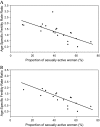Fertility of HIV-infected women: insights from Demographic and Health Surveys
- PMID: 21106511
- PMCID: PMC3173817
- DOI: 10.1136/sti.2010.043620
Fertility of HIV-infected women: insights from Demographic and Health Surveys
Abstract
Objective: To analyse the data from Demographic and Health Survey (DHS) linking HIV serological data and fertility, and to recommend new age-specific fertility rate (ASFR) ratios of HIV-positive women to HIV-negative women to be used in the WHO/UNAIDS HIV estimates.
Methods: The authors obtained ASFRs and ASFR ratios from HIV-infected women and HIV-uninfected women from 20 DHS surveys collected between 2003 and 2007. The authors then computed mean and median ASFR ratios, and performed general linear modelling to estimate the overall ASFR ratio for each age group, and finally performed an analysis to identify determinants to national ASFR ratio for women aged 15-19 years old.
Results: The overall ASFR ratio estimated by regression was highest among women aged 15-19 years old (ASFR ratio of 1.20), and decreased with age (ASFR ratio of 0.76, 0.71, 0.65, 0.59 and 0.53, respectively for every 5-year bracket of 20-44 years old). The mean and median of ASFR ratios among 20 countries were similar to the results above. The analysis suggested that country-specific proportion of sexually active women aged 15-19 years old could be a determinant of the ASFR ratio for this group. The higher proportion of sexually active women in this group suggested a lower ASFR ratio in young women.
Conclusion: This study confirmed previous findings of a high ASFR ratio among women younger than 20 years old, and of decreasing ASFR ratios with age among those aged 20 years or older, based on nationally representative data from a large number of countries. The study updated the assumptions used in the annual WHO/UNAIDS HIV epidemic estimates. Countries should compute their own ASFR ratio of 15-19-year-old women accounting for the sexually active rate among young females.
Conflict of interest statement
Figures



References
-
- Zaba B, Gregson S. Measuring the impact of HIV on fertility in Africa. Aids 1998;12(Suppl 1):S41–50 - PubMed
-
- Carpenter LM, Nakiyingi JS, Ruberantwari A, et al. Estimates of the impact of HIV infection on fertility in a rural Ugandan population cohort. Health Transit Rev 1997;7(Suppl 2):113–26 - PubMed
Publication types
MeSH terms
LinkOut - more resources
Full Text Sources
Medical
